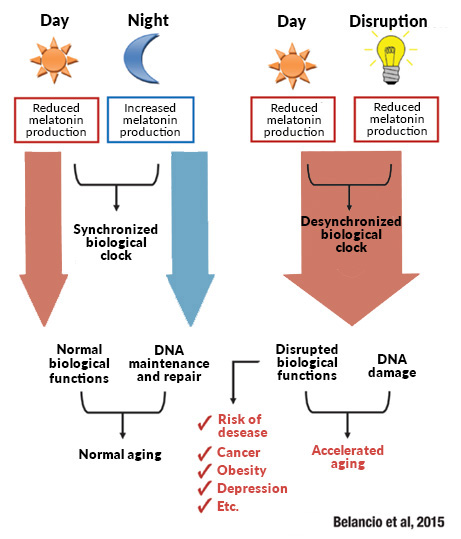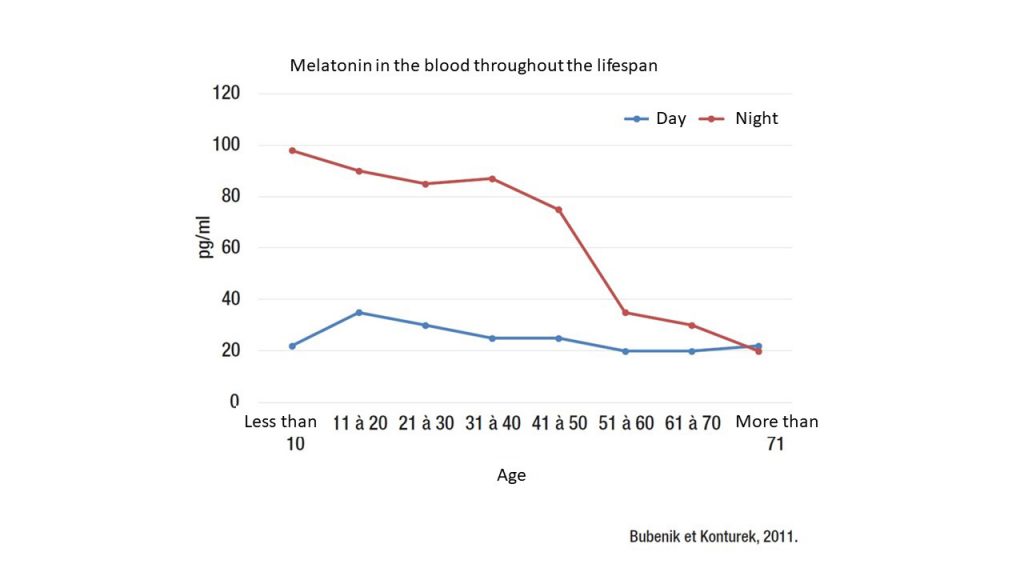From Chapter 3.3 of the book “Live Young, Longer”, by Éric Simard, 365 pages (currently only available in French).
Table of Contents
Discovered in 1958 by Aaron Bunsen Lerner, from Yale University in the United States; melatonin is a hormone particularly known for its ability to regulate chronobiological rhythms (circadian rhythms), improve sleep, and relieve jet lag (fatigue due to time difference).
Nicknamed as the sleep hormone, it is produced from tryptophan (an amino acid), especially by the pineal gland, but also from several other tissues, including the retina, digestive system, bone marrow, lymphocytes, skin, and bone tissue. It is produced by the pineal gland in response to variations in brightness (a sleep signal).
Origins going back to the dawn of time
Melatonin is found throughout the animal kingdom, in bacteria and even in plants. For many living organisms, melatonin and/or associated molecules play(s) a role of protection and adaptation to harsh environmental conditions. Several plants will increase their production of melatonin to protect themselves from certain difficult conditions as well as to reduce oxidative stress.
The role of this molecule in the living world is so well preserved that it is also responsible for the circadian rhythm (biological rhythm on a 24-hour basis) in certain microscopic algae.
The origin of this molecule could go back so far from an evolutionary point of view (3.5 billion years), that this would explain its presence throughout the living world, but also its importance in terms of health benefits.
It is even suggested that mitochondria, the small energy powerhouses in our cells, among symbiotic organisms, have retained their ability to produce melatonin. They could have possibly even passed down the recipe for production (DNA) of this molecule because it is so important for health. Regardless, the action of melatonin on the mitochondria is now indisputable and may be responsible in large part for its beneficial effects on aging processes.
The production of melatonin is stimulated by the decrease in light. We now know that this production of melatonin stimulates DNA repair and inhibits certain mechanisms that promote mutations. Thus, the production of melatonin plays an important role in our maintenance and repair processes, which could slow down aging.

Melatonin and telomeres
Perhaps there is a link between the short nights of sleep (5 hours or less) that are associated with short telomeres (which protect the ends of DNA fragments) and the production of melatonin? It was recently proposed that melatonin may help prevent age-related macular degeneration by keeping telomeres longer.
First, you should know that the production of endogenous melatonin (produced by our body) decreases with age, gradually dropping from around 170 pg/ml of blood around the age of 5, to less than 30 pg/ml of blood past the age of 70. This is a reduction of over 80%.
Melatonin is mainly produced at night. The blood concentration of melatonin during the night is 10 to 50 times higher than during the day. This melatonin, found in the blood, is produced by the pineal gland. Other organs may contain more or less of it, including the intestine, which may contain up to 400 times more than the pineal gland.
It is important to emphasize that this drop in melatonin, as we age, is more marked in women than in men. It’s also true that twice as many women as men experience sleep problems. In addition, the symptoms of menopause combined with the drop in melatonin make women’s nights more difficult.

Cancer and the immune system
On another note, the decrease in melatonin production as we age along with the increased incidence of cancer may be related. The role of melatonin has been well demonstrated in cancer prevention to limit the growth of cancer cells or to cause the death of tumors.
It is also known that a greater drop in melatonin is associated with a higher incidence of Alzheimer’s disease.
Likewise, if it is not the decrease in melatonin that is directly responsible for the disruption of the immune system, an additional intake of melatonin, as we age, could help keep it functional for longer. Melatonin would help keep the immune system functioning in a manner similar to what is seen in centenarians.
This would improve resistance to infections, but also prevent increased systemic inflammation. The increase in inflammation, with aging, predisposes or accentuates the development of diseases and disrupts the metabolism.
Its beneficial effects on the immune system and its protective effects against viral infections mean that melatonin could be used both in the prevention and in the treatment of certain viral diseases. It was recently proposed (2015) that melatonin could be an important ally in the fight against the Ebola virus.
Metabolism, cellular repair and antioxidants
Melatonin would help maintain a healthier and younger general metabolism. It would act upstream on the aging process by protecting the functioning of mitochondria and maintaining their density in cells. Melatonin would also increase the productivity of our energy powerhouses, while reducing their polluting emissions (oxidation). This is the exact opposite of what is generally seen with aging.
This beneficial effect may reduce the incidence of a large number of diseases, including degenerative diseases such as Parkinson’s and Alzheimer’s.
Another important mechanism linking melatonin to aging and to the mitochondria is the expression of the protein sirtuin 1 (Sirt 1). Sirtuins play a very important cellular role in stress resistance mechanisms both in the cytoplasm of cells and in the internal mitochondria. Thus, in a state of stress, these proteins can activate a large number of genes essential to the body’s natural antioxidant defenses, but also the cellular repair mechanisms. The expression of the antiaging protein Sirt 1 is increased by melatonin.
Melatonin is also a direct and indirect antioxidant. It has an antioxidant effect and it stimulates the natural defenses against oxidation. Its accumulation in certain organs could be linked to its antioxidant role. As an antioxidant, it also has the ability to be soluble in water and oils, which allows it to easily cross cell membranes.
In short, a higher level of melatonin would help keep the body functioning younger, longer. Interestingly, calorie restriction delays the decrease in melatonin production typically seen with aging.
Sources of melatonin
Melatonin is the name of the active ingredient, or N-acetyl-5-methoxytryptamine, for fellow science enthusiasts. The primary source of melatonin is, of course, our daily production at night.
Certain foods such as Montmorency cherries, cranberries and certain medicinal plants contain it, but the concentration is measured in picograms (1 pg = 0.000 000 000 001 g). We find a much larger amount in mustard seeds, almonds and pistachios.
Pistachios could contain up to 230 ug/g (which corresponds to 0.23 mg/g). However, it is not certain whether it is possible to get enough of it in the diet to increase its content in the blood. In addition, the gut microbiota – our bacteria living in the gut – could be a source of production or consumption.
The melatonin found in supplements was once extracted from the bovine pineal gland. Rest assured, it is now synthesized and is no longer of animal origin.
Pharmacology, effective dose and toxicity
Melatonin peaks in absorption within an hour. Its half-life (50% elimination) is estimated to be 35 to 50 minutes. The doses used in clinical studies (over 35 quality studies) vary from 0.3 to 10 milligrams, but a majority of studies are around 3 to 5 milligrams. For example, in clinical studies, in addition to helping sleep, a dose of 3 to 5 mg per day, before bedtime, significantly improved irritable bowel symptoms. Human studies that have used higher doses (1 to 6 grams = approximately 1000 times the recommended doses) have not shown significant side effects. Melatonin is said to be very safe.
Melatonin modulates several genes involved in the metabolism and physiology of the cardiovascular and immune systems, cancer detoxification and reduction, as well as in bone metabolism. We will discuss some important studies on these facets of health associated with aging.
There is a great deal of research interest in melatonin, not only for various sleep disorders, but also for several indications associated with aging. It is now widely accepted that melatonin improves all physiological parameters of the metabolic syndrome (metabolic imbalance caused by obesity: hypertension, blood lipids, body weight, glucose management, etc.). This would be the action on metabolic pathways regulated by calorie intake. These are the same metabolic pathways involved in the myriad of beneficial effects of calorie restriction. These same metabolic pathways are said to cause the body to age. This could explain the anti-aging effect of melatonin observed in animals.
Female hormones and gut health
Researchers have found that melatonin has Selective Estrogen Receptor Modulators (SERMs) and Selective Estrogen Enzyme Modulators (SEEMs) modulating effects of estrogen receptors which are of interest in breast cancer and in the prevention of osteoporosis.
More specifically, a pilot study involving 18 perimenopausal women (45-54 years) showed that the use of 3 mg of melatonin at bedtime for 6 months improved their quality of life.
Melatonin is thought to have several beneficial effects on the intestinal mucosa (mechanisms of action demonstrated in preclinical studies), which could explain the improvement in symptoms of irritable bowel syndrome and its beneficial effects on the intestinal tract. Melatonin receptors (MT1, MT2 and MT3) are present in the intestine and play a role in the regulation of motility (the ability to move), inflammation, and pain.
Side effects
Melatonin supplements are very well tolerated. Rare morning residual effects are experienced (light therapy and intense exercise help to eliminate these effects).
Interactions
Nifedipine: receptor competitor. To avoid. Synergistic potential with benzodiazepines and other sedatives.
Consult your pharmacist.
Pregnancy and breast feeding
Not recommended.
Contraindications
No absolute contraindication. Use precaution in the following cases: hormonal imbalance, diabetes, convulsions and psychiatric disorders.
Vitoli® Sleep
Vitoli® Sleep contains melatonin. However, melatonin alone mainly helps with falling asleep. It is seldom sufficient on its own to obtain a deep sleep and a full night’s sleep. This is why in Vitoli® Sleep is accompanied by quality extracts of valerian, passionflower and olive (powerful antioxidants; olive polyphenols). These four ingredients work in synergy to help all facets of sleep:
-
-
- Falling asleep,
- Deep sleep and
- A full night’s worth of sleep.
-
Note that it is possible to take up to two capsules, but usually one capsule is sufficient; 30 minutes to an hour before sleeping. Also, some people prefer to use Vitoli® Stress and Anxiety for sleep; this is a second option. It can be interesting to try both and see which one works best. Vitoli® Stress & Anxiety does not contain melatonin and is also used as one or two capsules, but usually one is sufficient, 30 minutes to an hour before bed.
Here are the claims permitted by Health Canada:
Vitoli® Sleep
-
-
- Helps reduce the time it takes to fall asleep.
- Helps increase the total duration and quality of sleep for individuals suffering from sleep restriction or altered sleep schedules.
- Traditionally used in Herbal Medicine to help promote sleep.
- Helps relieve nervousness and stress.
- Provides antioxidants.
-
Other suggested articles
References:
- Anderson et al. 2015. Ebola virus: Melatonin as a readily available treatment option. J Med Virol. 2015 Apr;87(4):537-43.
- Altun et al. 2007. Melatonin: therapeutic and clinical utilization. Int J Clin Pract. 2007 May;61(5):835-45. Review.
- Belancio et al. 2015. The aging clock and circadian control of metabolism and genome stability. Front Genet. Jan 14;5:455. Review.
- Bonnefont-Rousselot, D., Collin, F. 2010. Melatonin: action as antioxidant and potential applications in human disease and aging. Toxicology. Nov 28;278(1):55-67.
- Bubenik, G.A., Konturek, S.J. 2011. Melatonin and aging: prospects for human treatment. J Physiol Pharmacol. Feb;62(1):13-9. Review.
- Campos Costa et al. 2013. Aging, circadian rhythms and depressive disorders: a review. Am J Neurodegener Dis. Nov 29;2(4):228-46. Review.
- Campos et al. 2013. The Angiotensin-melatonin axis. Int J Hypertens. 2013:521783.
- Chen et al. 2011. Distribution, function and physiological role of melatonin in the lower gut. World J Gastroenterol. Sep 14;17(34):3888-98. Review.
- Costello et al. 2014. The effectiveness of melatonin for promoting healthy sleep: a rapid evidence assessment of the literature. Nutr J. Nov 7;13:106.
- Grossman et al, 2011. Effect of melatonin on nocturnal blood pressure: meta-analysis of randomized controlled trials. Vasc Health Risk Manag. 7:577-84. Review.
- Hardeland, R. 2013. Melatonin and the theories of aging: a critical appraisal of melatonin’s role in antiaging mechanisms. J Pineal Res. Nov;55(4):325-56. Review.
- Jenwitheesuk et al. 2014. Melatonin regulates aging and neurodegeneration through energy metabolism, epigenetics, autophagy and circadian rhythm pathways. Int J Mol Sci. Sep 22;15(9):16848-84.
- Karasek, M. 2004. Melatonin, human aging, and age-related diseases. Exp Gerontol. 2004 Nov-Dec;39(11-12):1723-9. Review.
- Kotlarczyk et al. 2012. Melatonin osteoporosis prevention study (MOPS): a randomized, double-blind, placébo-controlled study examining the effects of melatonin on bone health and quality of life in perimenopausal women. J Pineal Res. May;52(4):414-26.
- Lemoine et al. 2012. Efficacy and safety of prolonged-release melatonin for insomnia in middle-aged and elderly patients with hypertension: a combined analysis of controlled clinical trials. Integr Blood Press Control. 5:9-17.
- López et al. 2010. Mitochondrial Disorders Therapy: The Utility of Melatonin. The Open Biology Journal, 3, 53-65.
- Magnanou et al. 2009. The timing of the shrew: continuous melatonin treatment maintains youthful rhythmic activity in aging Crocidura russula. PLoS One. Jun 15;4(6).
- McMullan et al. 2013. Melatonin secretion and the incidence of type 2 diabetes. JAMA. Apr 3;309(13):1388-96.
- Mei et al. 2011. A protective effect of melatonin on intestinal permeability is induced by diclofenac via regulation of mitochondrial function in mice. Acta Pharmacol Sin. Apr;32(4):495-502.
- Mihandoost et al. 2014. Can melatonin help us in radiation oncology treatments ? Biomed Res Int. 2014:578137. Review.
- Pechanova et al. 2014. Peripheral and central effects of melatonin on blood pressure regulation. Int J Mol Sci. Oct 8;15(10):17920-37. Review.
- Rastmanesh R. 2011. Potential of melatonin to treat or prevent agerelated macular degeneration through stimulation of telomerase activity. Med Hypotheses. Jan;76(1):79-85.
- Sadowska-Bartosz, I., Bartosz, G. 2014. Effect of antioxidants supplementation on aging and longevity. Biomed Res Int. 2014:404680. Review.
- Sanchez-Barcelo et al. 2012. Breast cancer therapy based on melatonin. Recent Pat Endocr Metab Immune Drug Discov. May;6(2):108-16. Review.
- Sharma et al. 2014. Melatonin Reverses Fas, E2F-1 and Endoplasmic Reticulum Stress Mediated Apoptosis and Dysregulation of Autophagy Induced by the Herbicide Atrazine in Murine Splenocytes. PLoS One. Sep 26;9(9).
- Siah et al. 2014. Melatonin for the treatment of irritable bowel syndrome. World J Gastroenterol. Mar 14;20(10):2492-8. Review.
- Silvestri, M., Rossi, G.A. 2014. Melatonin: its possible role in the management of viral infections–a brief review. Ital J Pediatr. 2013 Oct 3;39:61. Review.
- Sommansson et al. 2013. Melatonin inhibits alcohol-induced increases in duodenal mucosal permeability in rats in vivo. Am J Physiol Gastrointest Liver Physiol. Jul 1;305(1):G95-G105.
- Sommansson et al. 2014. Long-term oral melatonin administration reduces ethanolinduced increases in duodenal mucosal permeability and motility in rats. Acta Physiol (Oxf). Oct;212(2):152-65.
- Song et al. 2005. Melatonin improves abdominal pain in irritable bowel syndrome patients who have sleep disturbances: a randomised, double blind, placebo controlled study. Gut. Oct;54(10):1402-7.
- Sun et al. 2013. Melatonin reduces bacterial translocation by preventing damage to the intestinal mucosa in an experimental severe acute pancreatitis rat model. Exp Ther Med. Dec;6(6):1343-1349.
- Tan et al. 2014. Fundamental issues related to the origin of melatonin and melatonin isomers during evolution: relation to their biological functions. Int J Mol Sci. Sep 9;15(9):15858-90. Review.
- Wang et al. 2015. Broad targeting of angiogenesis for cancer prevention and therapy. Semin Cancer Biol. Jan 16. Review.
- Witt-Enderby et al. 2006. Therapeutic treatments potentially mediated by melatonin receptors: potential clinical uses in the prevention of osteoporosis, cancer and as an adjuvant therapy. J Pineal Res. Nov;41(4):297-305. Review.
- Zhang et al. 2014. Melatonin Attenuates Noise Stress-induced Gastrointestinal Motility Disorder and Gastric Stress Ulcer: Role of Gastrointestinal Hormones and Oxidative Stress. J Neurogastroenterol Motil. Dec 26.






